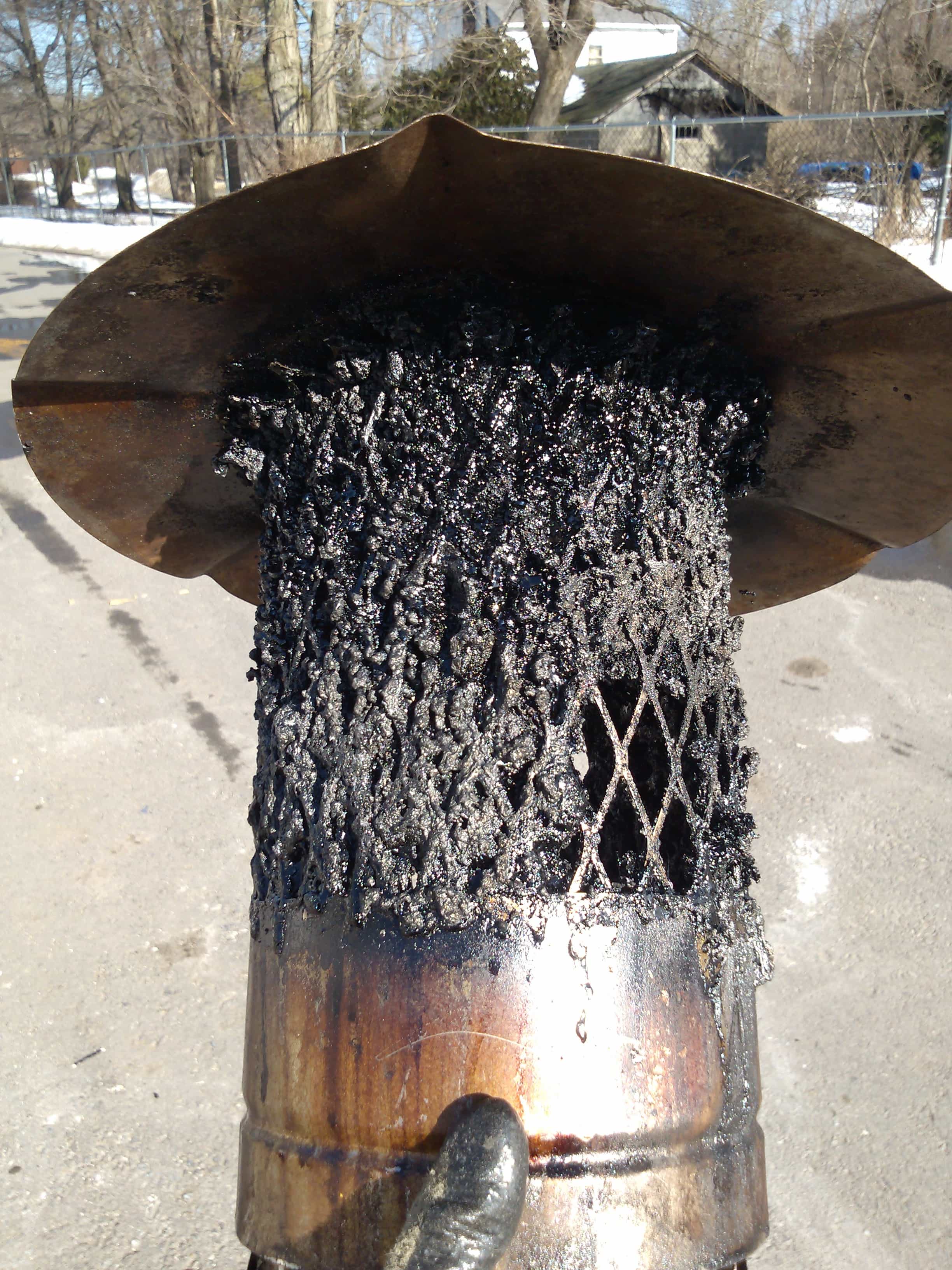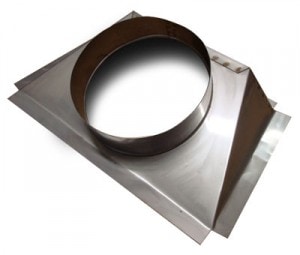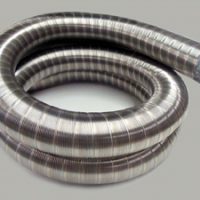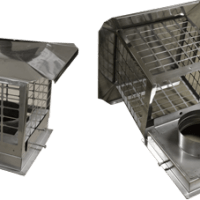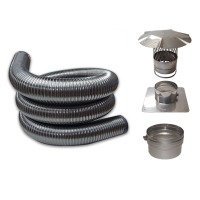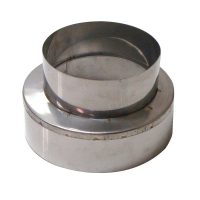Why insulate your stainless steel chimney liner?
Basically you need insulation for safety and performance. The safety issue is a no brainer. Keep the extremely high temperatures that can reach 2100 degrees away from your home and prevent a house fire.
The second reason, performance, is a more difficult one to understand for some. Here is a picture of a cap from a customer who did not use insulation around the stainless steel chimney liner. The smoke cools down too much and creates creosote. The screen was almost completely blocked on this rain cap.
Winter is coming!!!
Like it or not, snow and ice will soon be here. This means cold temperatures and firing up the stove and furnace. This year let us help you make sure your chimney is safe. The purpose of a chimney liner is to contain all of the harmful exhaust that is released from your appliance. These harmful gasses can leak into your home if your chimney does not have a liner.
With a stainless steel chimney liner all of the smoke and carbon monoxide is contained within the one piece flexible liner. This means your chimney and more importantly your family will be safe this coming winter and forever.
Don’t wait any longer to purchase your chimney liner. Call us today at 1-866-941-5112 to get the best pricing available.
Installing a Wood stove
Are you planning on installing a wood stove this winter? Is the high price of heating oil making you think about using alternative fuels? If so you have come to the right place for help installing a wood stove safely.
One of the most important parts of installing a wood stove is making sure your chimney is safe. To make your chimney the safest it can be, you need to install a stainless steel chimney liner with insulation. The best chimney liner available is our rigid chimney liner. If your chimney has bends or turns, we recommend installing the Flex King Pro HD.
The Flex King Pro HD is specifically designed to handle the exhaust of a wood burning appliance. Installing a wood stove can save you hundreds of dollars on your heating bill. Let us help you save hundreds of dollars on making your family and chimney safe this winter.
How do you clean a Fireplace?
Why do you clean a Fireplace?
Many people love coming home to see a cozy fire in the fireplace. This is always a favorite for special family occasion. Some people only burn wood in the fireplace occasionally while others have a warm fire every evening during the winter months. A fireplace can also be extremely dangerous. According to www.usfa.fema.gov, “Heating fires account for 36% of residential home fires in rural areas every year. Often these fires are due to creosote buildup in chimneys and stovepipes.” The main reason for these fires is carelessness and a lack of cleaning. We will discuss how to clean a fireplace.
How do you clean a Fireplace?
Cleaning and inspecting a fireplace annually can prevent multiple issues. Many homeowners clean their own fireplace chimneys. This is fine as long as you know how to thoroughly and properly clean a fireplace chimney. As seen in the diagram below, there are multiple components to a fireplace and its chimney. 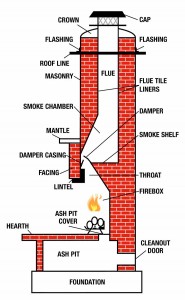
Once you seal up the opening of the fireplace to prevent dust from escaping, you can proceed to the roof. The first thing you need to know is the size of your chimney flue. The most common sizes for fireplace flues are 8″x13″ and 13″x13″. You will need a wire brush that fits snugly inside the flue. Now you can start by inserting the chimney brush from the top and working your way down. Sometimes if the flue has extra creosote build up, you may need to pass the brush through the flue multiple times.
The most important thing to know when you clean a fireplace.
Look at the above diagram closely. When you clean a fireplace flue, all the highly flammable creosote is not swept down the fireplace floor. It is resting on top of the smoke shelf. This is the most important spot to clean when you clean a fireplace chimney. Now you have a pile of flammable creosote just a few inches above the flame. You will need to reach up into the fireplace with a vacuum hose or other appropriate tool to remove all the creosote. Once you remove all of the creosote that is on the smoke shelf, you now need to sweep out the rest of the firebox and discard of all the ashes. These are the most basic steps in how to clean a fireplace and the chimney.
Round Stainless Steel Insert Boot
Round Stainless Steel Insert Boot
A round stainless steel insert boot is designed to make the connection from an insert between a square or rectangle flue outlet and a round chimney liner. Many old style fireplace inserts have a rectangle flue outlet. This is because at one time they believed it to be OK just to set the stove inside the fireplace and call it good. This is no longer the case. Now we know of the dangers caused by this type of install.
What size Insert Boot do I need?
Every stove needs a proper size chimney liner for proper draft. The square inches of the outlet on the stove needs to be as close as possible to the amount of square inches of the chimney liner. First, you measure the length and the width of the flue outlet on the stove (as seen in pic). Once you have your total square inches, you now know what size of insert boot you need. 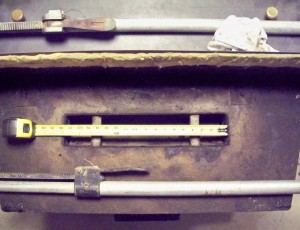
Insert Boot Measurements
A round chimney liner is designed to be mechanically mounted to the insert boot. The insert boot will also need to be screwed to the top of the insert. You need to install an insert boot that will accept a chimney liner that can handle the same amount of square inches as the outlet on the stove. This means for example, if your measurements are 4″ x 9.5″, your total square inches are 38″. Now it is as simple as finding a chimney liner that will handle 38″ square inches.
- 6″ chimney liner is 28.3 sq. inches
- 7″ chimney liner is 38.5 sq. inches
- 8″ chimney liner is 50.3 sq. inches
In conclusion, you will simply use the above chart to discover what size chimney liner you need and what size round insert boot you may need also. One possibility that you may encounter is, on some stoves, the flue outlet is extra large. The average insert boot may not cover the flue outlet. Do not worry. Give us a call and we can make one to any size you need. If you are still confused or have other questions about purchasing and installing a chimney liner and an insert boot, please contact us 1-866-941-5112 or visit us on Facebook.
Why do you need a chimney liner?
Why do you need a chimney liner?
You may ask, “Why do you need a chimney liner?”. You may think that your chimney has been there for almost a hundred years and as far as you know it is safe. So why is my chimney sweep telling me I need to install a chimney liner now?
Chimney liners are designed to keep the harmful gases of your furnace or creosote from the stove inside the chimney and keep them from entering your home. Many homes have a chimney with very old technology. They have terra cotta (clay) flue liners. They were designed to work with coal, they still do work for coal. But now very few people burn coal as a main heating source.
Why do you need a chimney liner if you are burning gas, oil or wood?
Today many people burn natural gas and home heating oil. The terra cotta flues were not designed to withstand the acids inside the exhaust. Wood burning stoves create creosote, that when hot, is a flammable liquid. This creosote can be seen in the picture leaking into the home. This is an extremely dangerous chimney. As you can see the flammable creosote is now entering into the home and can easily ignite, catching the home on fire. With gas and oil burning appliances, eventually the terra cotta deteriorates, creating he possibility of the chimney flues falling over inside the chimney. This will creat a blocked chimney, a very dangerous situation for your family.
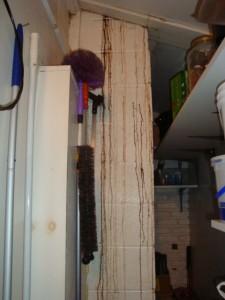
You need a stainless steel chimney liner, it is what will stand up to the harsh exhaust from a modern furnace and the dangerous creosote from a wood stove.
Why you need a chimney liner?
https://www.chimneylinerdepot.com/articles-2/chimney-liner-articles/do-i-need-a-chimney-flue-liner/
Seasoning Firewood
The importance of Seasoning Firewood
Now that the burning season for most of has finished, we have to start thinking about seasoning firewood for the seasons to come. Hopefully you already have your firewood split and stacked for the coming burning season. In a perfect world you would already have 2 years of firewood stacked. This is because some wood can take around 3 years to be ready to burn.
Dangers of not seasoning firewood
Many dangers can result in burning wet wood. This will create more creosote in your chimney. That is a fact, wet wood equals a dirty chimney. A dirty chimney puts you at a high risk of a chimney fire. Having unseasoned firewood means you have too much water in the wood. This also means you will not get as hot of a burn as you would like to in your wood stove, causing o to waste more wood than you would have to to heat your home. The glass on your stove also gets lots of creosote build up, taking away from the ascetics of a real fire.
One sign that your wood is too wet is that when it burns it is smokey. The best way to know if your wood is dry enough is to buy a moisture meter. Moisture content should be 20% or less. If it is much higher than that, your firewood needs to be dried. It is necessary to burn dry wood in any type of appliance.
So basically if you haven’t already started collecting your wood for this coming winter do it now. Seasoning firewood may take around 3 years for some wood, so start early and save yourself from the risk of a chimney fire.
Check out this video on showing you an interesting way how to stack firewood and start seasoning firewood:
Pellet Stove Chimney Liner
 Do pellet stoves need chimney liners? If you have an existing chimney that you would like to vent a pellet stove into you should install a stainless steel chimney liner. Why? In order for an appliance to run correctly it should vent into a chimney or pipe that is sized correctly. Most pellet stoves have 3 inch vent sizes. When installing a chimney liner for a pellet stove there is one thing to remember. If the chimney length is greater than 15 feet you should just up to a 4 inch chimney liner. In this case you will need to go from the 4 inch chimney liner tee down to 3 inch.
Do pellet stoves need chimney liners? If you have an existing chimney that you would like to vent a pellet stove into you should install a stainless steel chimney liner. Why? In order for an appliance to run correctly it should vent into a chimney or pipe that is sized correctly. Most pellet stoves have 3 inch vent sizes. When installing a chimney liner for a pellet stove there is one thing to remember. If the chimney length is greater than 15 feet you should just up to a 4 inch chimney liner. In this case you will need to go from the 4 inch chimney liner tee down to 3 inch.
Home Inpection of a Fireplace
Below are some excellent videos about inspecting your fireplace. Keep in mind Chimney Liner Depot carries a full line of chimney liners for fireplace chimney relining. Give us a call and we can help you determine what size chimney liner you need for your chimney relining job.

